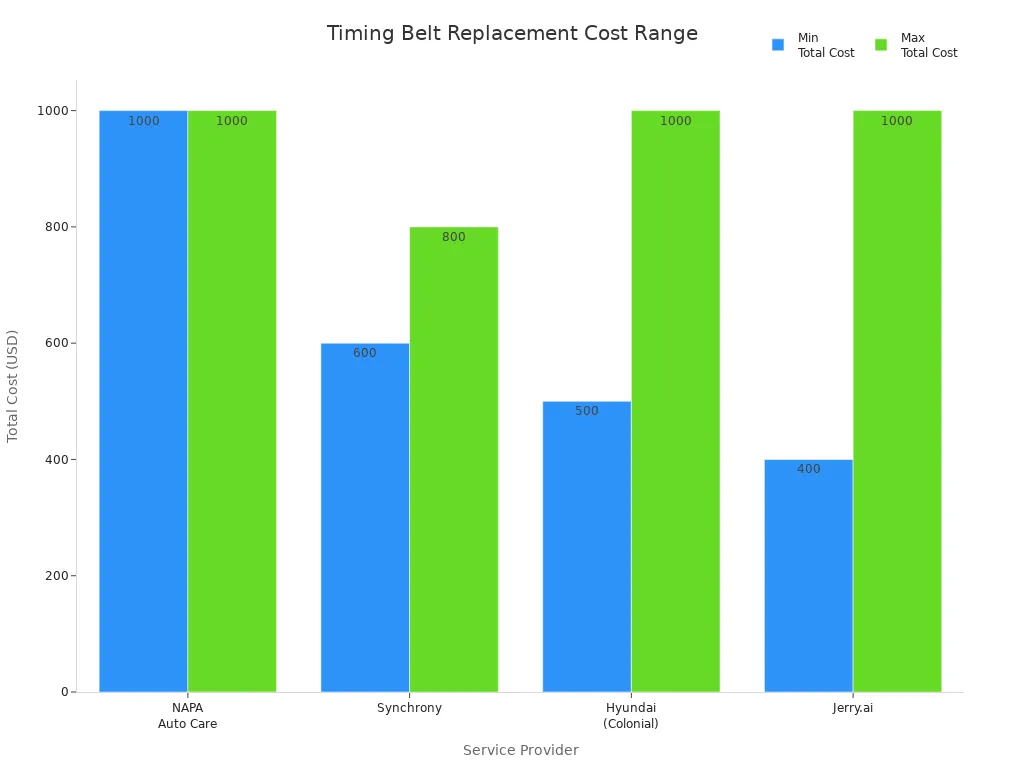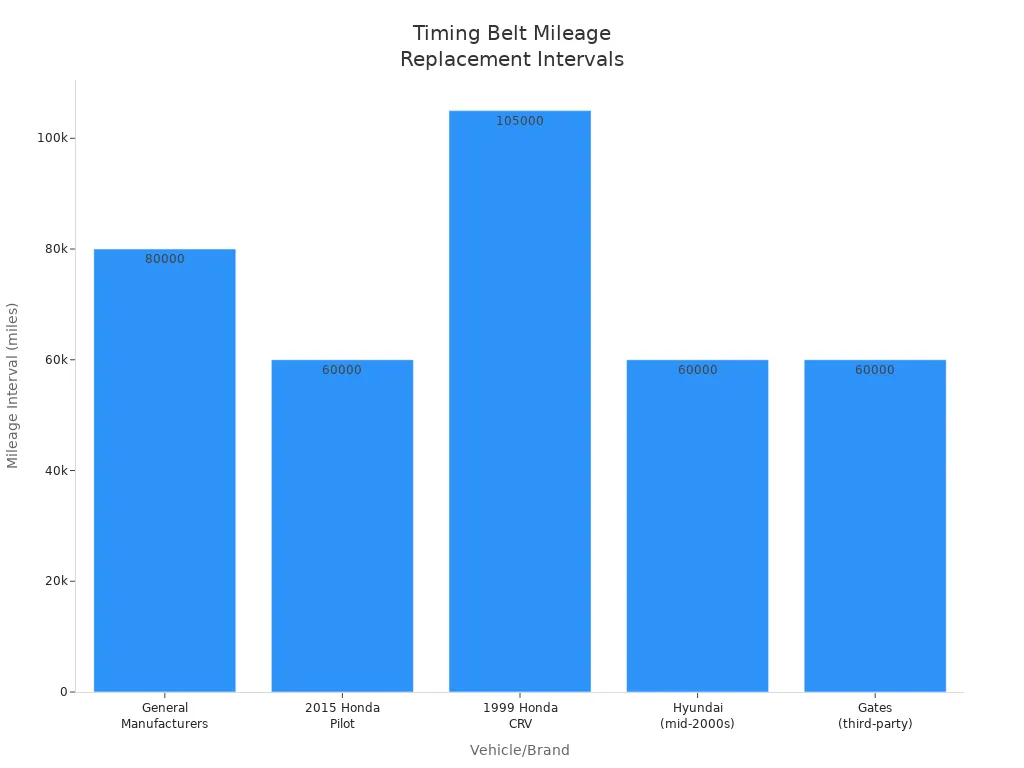Views: 0 Author: Site Editor Publish Time: 2025-07-28 Origin: Site









You can expect to pay between $580 and $1,400 to replace a timing belt in most parts of the United States. This price covers both the timing belt and the work to put it in. The cost depends on your car’s make and model, and where you live. For example, it usually costs more in big cities. If you also need to change other parts like the water pump or tensioner, the total price can go up. Look at the table below for a quick summary:
Category | Price Range (USD) | Notes |
|---|---|---|
General US Average | $580 - $1,400 | Parts and labor for timing belt replacement |
Smaller Cars | Around $310 | Easier access, lower price |
Luxury Models | $1,100 - $1,700 | Premium timing belt and more complex labor |
You may also see higher prices for timing belt replacement if your car uses special industrial belts or conveyor belts.
Replacing a timing belt costs about $580 to $1,400. This price includes parts and labor. The cost can change by car type and where you live. Labor is often half or more of the total price. If you add parts like the water pump or tensioner, it can cost more. You should change the timing belt on time. This is usually every 60,000 to 100,000 miles or every 5 to 7 years. Doing this helps stop expensive engine damage. You can pick a dealership or a local shop. Your choice depends on price, parts quality, and service. Both have good and bad points. Getting quotes from different shops can help you save money. Replacing related parts at the same time can also help your car run well.

You might wonder how much it costs to replace a timing belt. Most people in the United States pay between $400 and $1,400. This price includes both the timing belt and the work to put it in. For many cars, the usual cost is $600 to $1,000. The table below shows what different places charge:
Source | Parts Cost | Labor Time (hours) | Total Cost Range | Notes |
|---|---|---|---|---|
Jerry.ai | $100 - $350 | 3 - 5 | $400 - $1,000 | Water pump adds ~$100 |
Colonial Hyundai | $399 (OEM) | 3 - 5+ | $500 - $1,000 | Complexity affects price |
NAPA Auto Care | > $500 | 3 - 8 | > $1,000 | Labor and parts combined |
Synchrony | $300 - $400 | 3 - 5 | $600 - $800 | Water pump recommended |
The price for a timing belt change depends on parts and labor. Labor is often half or more of the total cost. Here is a chart that shows what different shops charge:

If your car uses special industrial belts or conveyor belts, it may cost more. These belts can take more time and skill to replace.
Many things can change how much you pay for a timing belt change. Here are the main things that matter:
Factor | Explanation |
|---|---|
Vehicle Make and Model | Some cars are harder to fix. This makes the job take longer and cost more. |
Labor Charges | Shops charge for the hours they work. Harder jobs mean higher labor costs. |
Additional Components | You might need a new water pump, tensioner, or pulleys. This adds to the total price. |
Quality of Replacement Parts | OEM parts cost more than aftermarket parts. |
Warranty Length | Belts with longer warranties usually cost more at first. |
Additional Repairs | If you need other repairs, the total cost can go up. |
Labor is the biggest part of the timing belt replacement cost. Most shops spend 3 to 8 hours on this job. If you add a water pump or other parts, it can take even longer. Parts usually cost less than labor. But high-quality timing belt kits can make the price go up.
Tip: Change the water pump and tensioner when you change the timing belt. This saves money later. You only pay for labor once and lower the chance of future problems.
Some shops offer packages with the timing belt, water pump, tensioner, and pulleys. These deals can save you money and give you peace of mind.
You can go to a dealership or a local shop for a timing belt change. Each has good and bad points.
Aspect | Dealership Advantages | Dealership Disadvantages | Local Shop Advantages | Local Shop Disadvantages |
|---|---|---|---|---|
Technician Expertise | Factory-trained, brand experts | Limited to specific brands | ASE-certified, broad experience | May lack brand-specific knowledge |
Parts Used | OEM parts, high quality | Higher parts cost, possible delays | Can use OEM or aftermarket, lower cost | Quality may vary |
Pricing | Competitive for routine service | Higher price for complex repairs | Lower price, especially for timing belt jobs | Price varies, trust can be an issue |
Customer Service | Service advisors handle communication | Less direct contact with technicians | Personalized service, direct interaction | Finding a good shop can take time |
Warranty & Benefits | Goodwill payments, warranty coverage | Higher overhead costs | Some honor third-party warranties | Less warranty coverage |
Dealerships usually charge more for a timing belt change. Their labor costs are higher and they use only OEM parts. You might pay $700 to $800 at a dealer. But you get a warranty and experts who know your car brand. Local shops often charge less, sometimes $600 or less for the same job. They may use aftermarket parts, which can lower the price. Many local shops have ASE-certified mechanics who can fix many brands.
Note: If your car is still under warranty or you want only OEM parts, a dealership may be best. If you want to save money and get more personal service, a trusted local shop is a good choice.
When you compare prices, always ask what is included. Some shops include the water pump, tensioner, and coolant in the price. Others may charge extra for these parts. Getting a clear quote helps you avoid surprises.

When you get a timing belt replacement, you get more than just a new belt. Most shops do a full service. This means they change several important parts and do the work to put them in. Here is what you usually get:
Timing belt: This part keeps your engine working together.
Water pump: It sits behind the timing belt and can wear out.
Tensioner and idler pulleys: These keep the timing belt tight and moving right.
Serpentine belt: Mechanics may change this if it looks worn out.
Coolant: They drain and refill this during the job.
Labor: Workers take off covers, old belts, and sometimes hoses or clamps.
You pay for both the parts and the work. Labor takes about four to six hours, but it depends on your engine. Shops use special tools and trained workers to do the job right. Many shops give a warranty for the parts and the work.
Tip: Getting all these parts changed at once saves money. It also helps your car last longer.
A full timing belt service can include more than just the main parts. Mechanics might tell you to change extra parts to stop problems later:
Camshaft and crankshaft oil seals: These stop oil leaks that could hurt your new timing belt.
Thermostat: Sometimes changed to keep your car running well.
Spark plugs and wires: Easy to reach when doing timing belt work.
Radiator hoses and antifreeze: Changed if they are old or worn out.
Valve cover gasket: Changed if it is leaking.
If you only change the timing belt and skip these other parts, you could have engine trouble or big repair bills later. In some engines, a bad tensioner or water pump can make the timing belt slip. This can bend valves or even ruin your engine. Getting a full timing belt service keeps your car safe and running well.
You can buy good timing belts and industrial belts from Uliflex. They are a trusted maker with lots of experience in conveyor belts and custom parts for many jobs.
You should follow your car’s maintenance schedule for timing belt changes. Most car makers say to change the timing belt every 60,000 to 100,000 miles or every 5 to 7 years. Do whichever comes first. Some brands, like Hyundai, want you to change it at 60,000 miles or after 4 years. Gates, a top belt maker, also says 60,000 miles is a good rule. Always look in your owner’s manual for the right timing belt change time for your car.
Here is a quick table for some popular car brands:
Vehicle/Brand | Mileage Interval | Time Interval | Notes |
|---|---|---|---|
General Manufacturers | 60,000–100,000+ miles | 5–7 years | Replace at whichever comes first |
2015 Honda Pilot | 60,000 miles | N/A | Manufacturer-specified |
1999 Honda CRV | 105,000 miles | 7 years | Interference engine; avoid engine damage |
Hyundai (mid-2000s) | 60,000 miles | 4 years | Conservative interval |
Gates (aftermarket) | 60,000 miles | ~6 years | Standard recommendation |

If your car has an interference engine, you must follow these times. If the timing belt breaks, pistons can hit valves. This can cost a lot to fix. Non-interference engines do not get this damage, but your car can still stop working if the belt breaks. Always check what kind of engine you have and follow the right schedule.
There are some signs that show your timing belt needs to be changed. Watching for these signs can help you avoid big engine problems. Here are the most common ones:
You hear a ticking noise from the engine. This can mean the timing belt is worn or loose.
The engine will not start. If the timing belt breaks, the engine will not turn over even if the starter works.
The engine misfires or runs rough. A slipping timing belt makes the cylinders open and close at the wrong time.
Oil leaks near the timing belt cover. Oil can make the belt wear out faster.
The check engine light comes on. The car’s computer may find timing problems and warn you early.
If you see any of these signs, get your timing belt checked soon. Waiting can make engine parts go out of sync. In interference engines, pistons can hit valves and cause big damage. Fixing this can cost thousands, much more than just changing the timing belt.
Remember, Uliflex sells strong timing belts, conveyor belts, and industrial belts for many uses. Using a good belt helps your engine and machines work well.
You can save money on timing belt replacement by taking a few smart steps. Prices for this service can change a lot from one shop to another. Some shops charge more because of higher labor rates or expensive parts. You should always ask for a quote from at least three or four shops before you decide. This helps you find the best deal and avoid paying too much. Many car owners find that comparing quotes leads to big savings, especially if you choose a shop with good reviews and fair pricing.
When you get a detailed quote, check what is included. Some shops add extra charges for parts like the water pump or tensioner. Others may include these in the price. Ask if the shop uses high-quality timing belts and if they offer a warranty. You can also save money by bundling repairs. For example, if your car needs a new serpentine belt or water pump, ask the shop to replace them during the same visit. This way, you pay for labor only once.
If you want even more value, look for timing belt replacement specialists. These experts know how to work quickly and safely. They often use trusted brands like Uliflex, which also makes conveyor belts and v belts for many industries.
Tip: Always read reviews and ask friends for recommendations before choosing a shop. A trusted mechanic can help you avoid future problems.
You might think about changing the timing belt yourself to save money. Doing it yourself means you do not pay for labor. Some people enjoy learning about their car and fixing it on their own. However, this job is very hard and risky.
DIY timing belt replacement can save you money on labor.
You may feel proud if you finish the job yourself.
Mistakes can cause serious engine damage, which may cost thousands to fix.
You need special tools and strong mechanical skills.
Professional mechanics have the right tools and experience. They can finish the job faster and check for other problems. Most shops give you a warranty on parts and labor. This gives you peace of mind. Professionals often spot issues early, which can save you money later.
For most people, hiring a professional is the safest choice. The cost is higher, but you protect your engine and avoid costly mistakes.
If you want your car to last, choose a shop that uses quality timing belts and offers a warranty. Uliflex provides reliable timing belts and other industrial belts that keep machines running smoothly.
You will usually pay between $600 and $1,000 to replace a timing belt. This price includes both the parts and the work to put them in. The table below shows how the type of car, the cost of parts, and the hours of work can change the total price:
Vehicle Type | Parts Cost | Labor Hours | Total Cost |
|---|---|---|---|
Domestic | $157 | 3–8 | $350–$1,000+ |
Trucks/SUVs | $409–$539 | 3–8 | $350–$1,000+ |
Smaller Vehicles | $169 | 3–8 | $350–$1,000+ |
Changing your timing belt on time stops engine problems that are very expensive to fix. Always get quotes from different shops and ask what is included in the price. Pick a mechanic who knows how to do timing belt jobs. Learning about timing belt service helps you keep your car safe and save money. Uliflex makes strong timing belts, conveyor belts, and v belts that last a long time.
You should replace your timing belt every 60,000 to 100,000 miles or every 5 to 7 years. Always check your owner’s manual for your car’s exact schedule. Timely replacement helps you avoid costly engine damage.
A worn timing belt can break without warning. Your engine may stop running. In some cars, this can cause serious engine damage. You may face expensive repairs. Always replace the belt before it fails.
You should not drive with a bad timing belt. The belt could snap at any time. This can leave you stranded. It may also damage your engine. Schedule a replacement as soon as you notice any warning signs.
Timing belt kits include the belt, tensioner, and pulleys. Some kits also have a water pump. Using a kit ensures all parts work well together. You get better value and longer-lasting performance.
You can find high-quality timing belts, conveyor belts, and v belts at Uliflex. Uliflex offers durable products for many industries. You can also explore polyurethane belts for specialized needs. Visit their product page for more details.
On October 28, 2025, the four-day 2025 China International Textile Machinery Exhibition and ITMA Asia Exhibition (Singapore) grandly kicked off at the Singapore Expo Center.
This week, Uliflex's colleague handling customer relations received a request from a new customer who learned about Uliflex at the 2025 PTC Shanghai exhibition. The customer's factory has multiple packaging production lines and wants to replace a new batch of industrial belts for transmission for th
Uliflex will participate in the "2025 China International Textile Machinery Exhibition&ITMA Asia Exhibition" in Singapore from October 28th to 31st, 2025, which will be held at the Singapore Expo Centre. Uliflex's booth is located at B401 in Hall H3. We welcome customers, peers, experts and scholars
The timing belt is a crucial component of your vehicle's engine, ensuring that the crankshaft and camshaft operate in perfect synchronization. Over time, the timing belt can wear out, leading to potential engine damage if not replaced in a timely manner. Understanding the cost of timing belt replacement is essential for budgeting and maintaining your vehicle's performance. In this article, we will explore the average cost of timing belt replacement, factors that influence the cost, and when it is recommended to replace your timing belt
Replacing a belt on a conveyor system is a crucial task that ensures the continuity, safety, and efficiency of industrial operations. Whether you're working in food processing, manufacturing, textiles, or packaging, knowing how to change a conveyor belt effectively can reduce downtime, improve system performance, and extend the lifespan of your equipment. With the increasing variety of materials like PU conveyor belts, PVC conveyor belts, and specialized options like timing belts and polyurethane belts, selecting the right replacement and learning the process is essential.
You want your car to run smoothly and avoid costly repairs, right? Taking care of your timing belt makes a huge difference. Regular timing belt maintenance helps prevent engine damage, which can lead to expensive headaches down the road. With some patience and the right tools, you can handle this job at home. For the best results, always pick a quality timing belt from a trusted supplier like Uliflex.
When installing polyurethane synchronous belt we need to pay attention to the problem: 1. before the installation of the belt, must first remove foreign body 2. installing a synchronous belt don't kink belt 3. adjust the belt tension wheel, until appropriate tension 4. tighten mounting bolts, correc
This week, Uliflex received an Egyptian client who had business communication at the 2025 PTC Shanghai exhibition at the end of October to visit Uliflex for on-site inspection. The customer is an industrial belt distributor and is looking for a long-term cooperative industrial belt manufacturer in C
Professional Industry Belt Manufacturer

